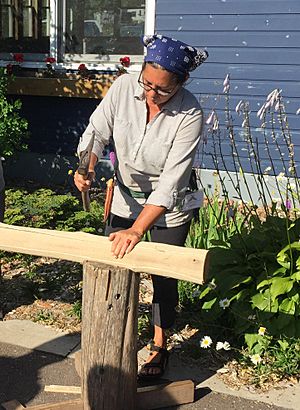April Stone facts for kids
April Stone is a talented artist who creates beautiful baskets. She is a member of the Bad River Band of the Lake Superior Chippewa people, also known as the Ojibwe, from Wisconsin. April is a full-time artist. She teaches others how to weave and sells her unique baskets across the Midwest.
Contents
Discovering Black Ash Basketry
April Stone began working with a special material called black ash in 1998. She learned about it with her husband, Jarod Dahl, after taking classes at the North House Folk School in Grand Marais, Minnesota. April became very interested in black ash basketry when she fixed her husband's broken basket. He used it every day to carry his lunch.
Learning to Weave
April looked for other black ash basket weavers in her community. When she couldn't find any, she decided to teach herself. She learned by reading books and carefully studying old baskets in museum collections. April and Jarod started a business together called Woodspirit Handcraft. They made traditional baskets and kitchen items. Their work combined their Ojibwe and Scandinavian family backgrounds.
April Stone's Art and Message
April Stone's basket-making is inspired by nature. She loves the idea of living off the land. She gathers the black ash wood herself. She carefully pounds a freshly cut log until the tree's rings separate into thin pieces. These pieces are then prepared and cut into strips, ready for weaving.
Speaking for the Trees
April makes useful baskets, but her art also carries an important message. She uses her work to talk about the danger facing black ash trees. These trees are being destroyed by a tiny bug called the emerald ash borer. This bug is an invasive species, meaning it's not native to the area and causes a lot of harm.
The Ash Burial Basket
In 2015, April received a special award called a Regional Artist Fellowship. She used this award to create a large "ash burial basket." This basket was a tribute to the dying black ash trees. She spent over 100 hours making this basket. Many people from the community helped her weave parts of it in a public space. The Minnesota Historical Society later bought this important burial basket for their collection.


